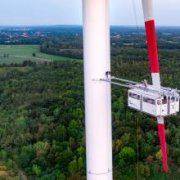Lightweight construction with polyurethane timing belts
Lightweight construction with polyurethane timing belts
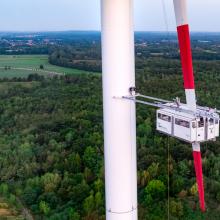
Mobile service platform terra 1.1 for wind power plants. Photo: WPS
A barely manageable demand for rotor blade repairs is looming on the horizon in the wind power industry. The solution: A mobile service platform of the Brandenburg-based company WP Systems GmbH has doubled the number of possible maintenance assignments per year compared to previous systems. The platform features BRECO® timing belt drives, which play an important part in weight reduction.
We are witnessing a positive trend: With 100 terawatts supplied by onshore wind power plants, this eco-friendly power source was the second most common source in 2018, ahead of even nuclear energy and coal. However, the necessary systems cannot withstand their expected 20 year service life without repairs and service work. It is hard to believe, but the rotor blades made of glass fibre reinforced plastic are particularly affected by erosion, lightning strikes and tears caused by high fluctuating loads.
In Germany, the rotor blades are generally inspected every two years by service technicians using cable systems. “However, repair work on a cable has not stood the test of time and proper laminate repair work is just not really possible when you are working from a cable,” explains Ole Renner, one of the two directors of WP Systems, a company specialising in maintenance of rotor blades and dismantling of wind power plants. He adds: “There is a trend toward mobile service platforms. The state of the art today is represented by open service platforms, i.e. open frame structures which bring to mind mobile scaffolds. Once their frame is stabilised on the tower, they are hoisted up on the rotor using winches. These simple service platforms allow our service technicians to sand the rotor blades, laminate them with polyester resin and seal them with a coating.”
But a problem remains: Application of laminates and resins is only possible when there is barely any rain and temperatures are no lower than 12°C. This makes rotor repairs practically impossible in winter and leaves only a few hours a day in the transition periods. It is also impossible to perform repair work in wind speeds of over 12 m/s.
Ole Renner explains: “So far, these three factors have limited the possible service days to an average of only 60 to, at most, 100 days per location. That is the result of our statistical analysis of weather data for several wind parks. For the industry, this seasonal business with 30,000 plants in Germany alone is a huge challenge.”
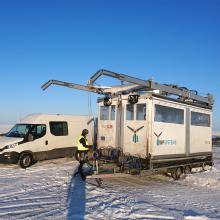
The tandem axis trailer with the service platform system terra 1.1 of WP Systems in Sweden. The permissible total weight of 3.5 tonnes must not be exceeded. Photo: WPS
Concept for the system terra 1.1
Holger Müller, an expert with years of experience in the field of wind power and director of WP Systems explains the idea of the mobile service platform terra 1.1 like this: “Our approach was to develop a complete system, which would allow year-round rotor blade repairs. That requires not just one but several innovations:
- To provide a dry environment, the service platform must form a water-tight enclosure around the repair area. Moreover, the mechanism must be adaptable to various contours and cross-sections.
- A solution for applying resins at low temperatures must be found.
- The service platform must be transportable with conventional tandem axle trailers. This means that the weight of the trailer and platform is limited to 3.5 tonnes.”
With this complicated goal in mind, an interdisciplinary team of machine engineers and experts in materials and lightweight construction as well as simulation specialists founded WP Systems in 2015. Within only a few years, the new team fulfilled all requirements with the terra 1.1 system, including the extremely stringent ones for a certification that includes work at night.
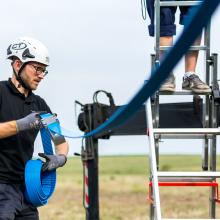
The 15.5 metre long telescopic frame consists of several segments to permit transport on a trailer. It’s a good thing that the timing belt of the same length is easy to roll up and unroll. Photo: WPS
Structural solution for the service platform terra 1.1
The new service platform terra 1.1 is really a mobile workshop. It consists of a lightweight aluminium structure, which can be turned into a wind-proof work chamber using tarpaulins and doors and is equipped with everything that is necessary such as power, light, tools and repair materials.
To close the gap between the rotor blade and the floor or ceiling in a flexible manner, adjustable covers were developed in Ruhland, which are adapted to the aerodynamic contours of the rotor blades. They can be positioned at a distance of only a few centimetres from any rotor blade.
A rubber sheet with suction cups seals the remaining gap between the covers and the rotor blades to make it water-tight. This makes it possible to perform repairs even when it is raining.
To allow resin to be applied on days with temperatures below 12 °C, the developers at WP Systems use infra-red radiators to heat up the repair area. Within only a few minutes, this method creates temperatures of over 30 °C, even in low ambient temperatures.
Moreover, the polyester resin and hardener are stored in a heated transport box to ensure that the temperature chain is never interrupted. With this type of preparation, repair work of any duration is now possible at temperatures as low as 0 °C and even, for brief periods, at temperatures as low as -10 °C.
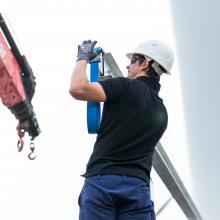
The timing belt is installed in next to no time with a click-in system. Photo: WPS
Timing belt drives for supporting and rotating the work chamber
Moving the chamber along the rotor blade mainly requires three different movements: Height adjustment using cable winches, the movement and support on the tower using the support structure and the rotation of the chamber around its vertical axis, so that it can follow the contours of the rotor blade as closely as possible.
The chamber is suspended by rollers from two C-arch sections to permit rotation.
The arch sections themselves are screwed to an aluminium hollow section frame. The hollow sections on its long side are guided on a 15.5 metre long support frame.
It was a special development challenge to keep the weight lower than the permissible total weight of the tandem axis trailer of 3.5 tonnes.
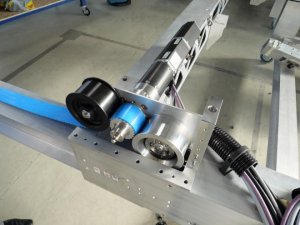
Highly suitable for humid and wet environments and particularly lightweight: Aluminium sections and the BRECOprotect® timing belt. The belt is positioned on the outside above the telescopic frame. The high transmission ratio of the servo gear permits use of a small, lightweight motor with an integrated brake. Photo: Mulco
The greatest challenge: Weight reduction
Ole Renner describes the conflicts of objectives: “Even though we made consistent use of the opportunities offered by lightweight construction from the very beginning, we had to come up with something new for the drive of the hollow section frame on the 15m telescopic frame, so that we could maintain the target weight. Rack and pinion drives made of steel are simply too heavy. A systematic comparison of drive types soon showed us the potential of lightweight timing belt drives."
André Schmidt, sales engineer at the Leipzig location of the Mulco partner Wilhelm Herm. Müller GmbH & Co. KG (WHM) describes the start of the project: “WP System’s plan was simple yet ingenious: The timing belt is fastened to the end of the support frame and an omega timing belt drive on the bearing frame moves the work chamber to the desired position. However, our first designs were followed by a "rude awakening."
The calculated tensile force was so high that it clearly exceeded the permissible forces for the support frame - particularly at the top position of the service platform near the rotor shaft - creating a risk of buckling.
Higher dimensions for the steel sections were out of the question for weight reasons.
André Schmidt: "We then suggested to WP Systems that the two belt deflection mechanisms of the omega drive should be positioned so closely to the belt pulleys that they would create a positive guide for the timing belt around the pulley. This makes the high tensile force unnecessary for this application.”
Ole Renner says: “This modification was very important for us and extremely helpful. We were able to maintain the dimensions of the support frame and finally achieve our target weight.”
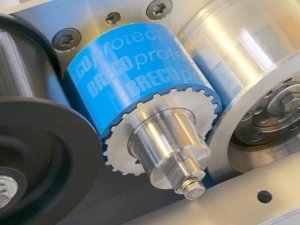
Small trick - great effect: Positive guide of the timing belt around the belt pulley. Photo: Mulco
Stable and weather-proof: BRECOprotect®
André Schmidt explains how the most suitable timing belt was selected: “Standard timing belts have coiling noses at the tooth root surface. The steel tension members are unprotected in this area and if the environment is humid, corrosion may occur. BRECO offers stainless steel tension members, but they are not as firm as steel tension members. This means that the stainless steel version would have made the drive wider and heavier. For this application, the open-length BRECOprotect belt with fully protected steel tension member was the ideal solution, because, among other reasons, the polyurethane of this belt is particularly resistant to humid environments.”
WP Systems used the same drive method for rotating the enclosure. In this case, the timing belt is clamped to the inside of the curved C-section and fastened to its ends, with another omega drive between them. André Schmidt explains the added potential of this drive solution: “As this example clearly shows, an omega timing belt drive on a segment of a circle is ideal for implementing rotary, tower and pivot drives for practically any diameter. The drive requires no lubrication and is corrosion-proof.”
Ole Renner sums up the past three years of collaboration with the Mulco partner WHM and their practical experience to date: “We are very satisfied with the drive, in particular with the extremely high tensile forces that BRECO timing belts can transmit despite their low weight. That’s impressive. Mr. Schmidt and BRECO Antriebstechnik also responded to our many detailed questions during the development phase unexpectedly fast and found answers to all of them. We can now offer the wind power industry a mobile system solution for rotor blade repairs, which can be used on an average of 200 days. That makes it possible to double the repair work performed while maintaining the same personnel cost, thereby easily doubling turnover. BRECO timing belts contributed to this success.“
Garbsen, 15 March 2019
Mulco-Europe EWIV

